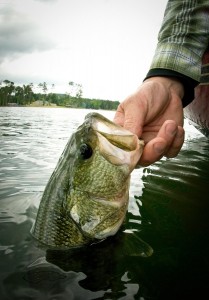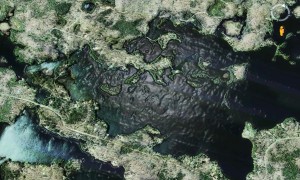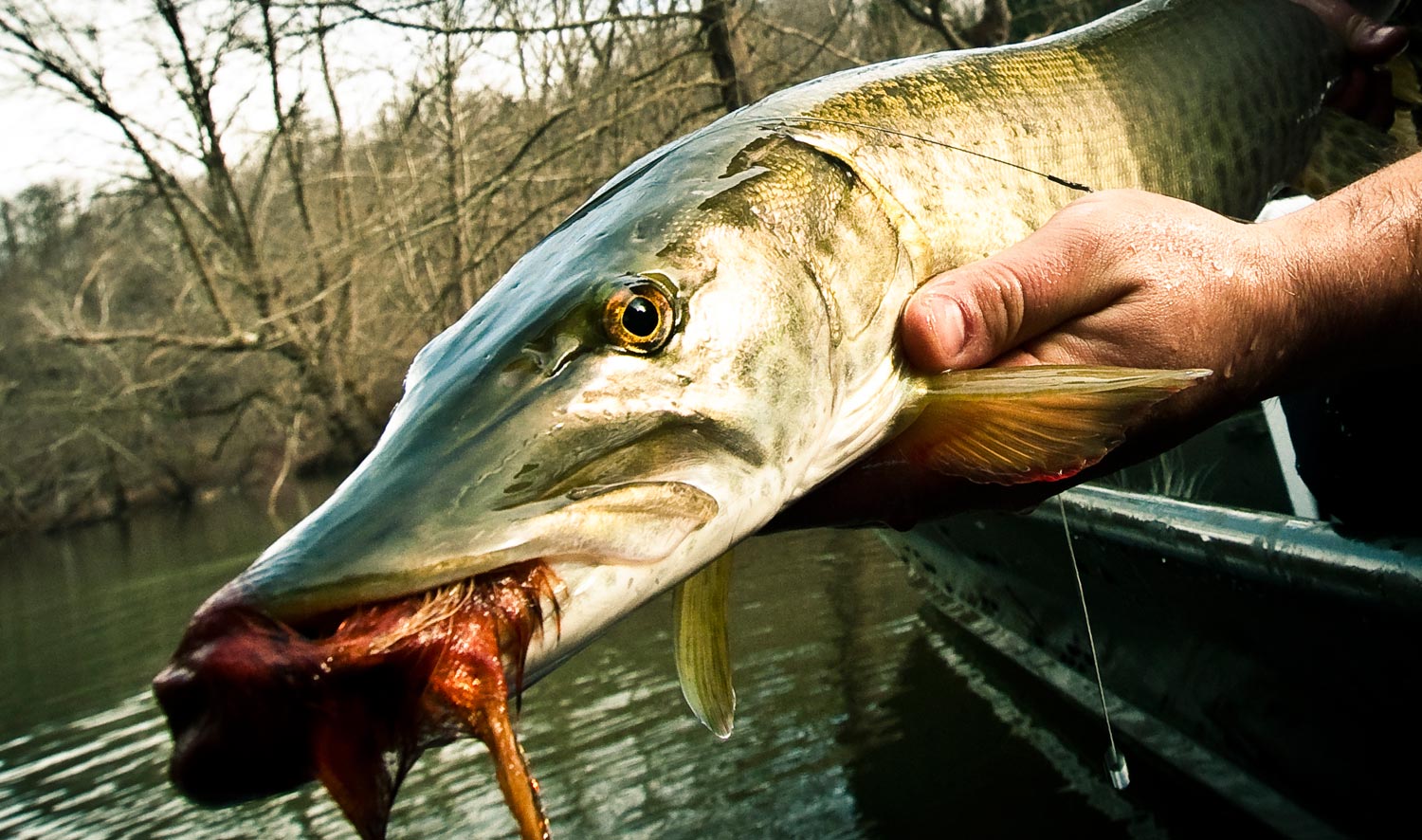by Rob “Amish” Bolger
In the summer of 2004, my father took my family and me on a vacation to a small town in the North Woods of Wisconsin.
Fishing had always been a huge passion of mine and coming from Denver, I was shocked by the vast amount of fishable water the Mid-West contained. Since that summer vacation, I have made an annual fishing trip to the North Woods every spring and my skills fishing large lakes have grown exponentially in that time. These are a few tips I have stumbled upon over the years for bass, musky and scouting water.
Spring Time Bass on the Fly
 Springtime in Northern Wisconsin has provided some of the most active large and small mouth bass fishing I have ever experienced. The key to finding the bass is fishing the shoreline, using the trolling motor to slowly work along shorelines. Fishing close to docks and submerged stumps or logs will be the most effective way to find fish. When selecting the lake you want to fish, I have always found that lakes with fewer docks and more natural shore with coontaill weeds and submerged logs will always hold better fish than lakes with docks choking the shoreline. While docks can provide great habitat, nothing can beat natural fish homes. After finding areas that hold bass, fly selection is the next step; with bass I only have two flies in my box, green poppers and white or black zonkers. If you get either of these flies in front of a bass’ face… they will eat.
Springtime in Northern Wisconsin has provided some of the most active large and small mouth bass fishing I have ever experienced. The key to finding the bass is fishing the shoreline, using the trolling motor to slowly work along shorelines. Fishing close to docks and submerged stumps or logs will be the most effective way to find fish. When selecting the lake you want to fish, I have always found that lakes with fewer docks and more natural shore with coontaill weeds and submerged logs will always hold better fish than lakes with docks choking the shoreline. While docks can provide great habitat, nothing can beat natural fish homes. After finding areas that hold bass, fly selection is the next step; with bass I only have two flies in my box, green poppers and white or black zonkers. If you get either of these flies in front of a bass’ face… they will eat.
Musky
Few fish in the freshwater excite me more than Northern Wisconsin Musky, also few fish in the freshwater have challenged me more, time and time again. It is this challenge that excites me and keeps me hunting the fish of ten thousand casts. Being that musky are an incredibly hard species to hook and even harder to land, it is crucial to use your casts wisely; for my first ten thousand casts, I found this out the hard way. After my next thirty thousand I’ve learned to make my casts count and this is how. Number one tip, speed. If you’re not getting follows or hookups, change your speed to be faster. Reactionary strikes are going to be your best bet when targeting musky and speed is often a good trigger that motivates spooky fish to eat. Another great trigger is pausing your retrieve. Often when you’re getting follows with no hookups it’s a good idea to pause several times throughout the retrieve. Pauses do not need to be more than a second or two, but often a following fish will eat if presented with a fly that pauses and quickly returns to its retrieve. This has been most successful during a figure eight pattern at the end of the cast; while presenting a following fish with a figure eight, sudden pauses have made my figure eights far more successful. The final and biggest tip, set the hook… Again. Anglers may go hours or even days without seeing a musky so it is crucial that when the stars align and you actually get one to eat, don’t forget to set the hook sometimes more than once to ensure a better chance at landing it. Musky fishing is an extremely challenging sport, both physically and mentally. With a little bit of preparation, positive mindset and dedicated fishing attitude, musky can be an incredible fish to chase.
Scouting Water
 Often anglers make the mistake of overlooking the important process of scouting the water; though it may be tough on lakes with very large acreage, it is extremely helpful to have an area mapped out via Google Earth or local lake maps prior to fishing. Then after launching the boat and prior to fishing go to the areas you have selected and drive the boat throughout the area; search for the spots where the weed beds begin and where they end. Find spots with submerged structure and mark these spots with the fish finder or on a local map. After the area has been thoroughly scouted go back and rethink your game plan. Just like anything in life, preparation is the majority of the work. If you have selected the weed beds and structure worth fishing, go back and start by fishing just outside the weeds and work you way in or vice versa, start inside and work your way out. However you fish the areas you have found, the most important part about fishing new water is scouting it. Even on lakes I know very well, when returning in a new season or new year, I scout the water every single time. If you know the structure of the lake well, the fish will come easily.
Often anglers make the mistake of overlooking the important process of scouting the water; though it may be tough on lakes with very large acreage, it is extremely helpful to have an area mapped out via Google Earth or local lake maps prior to fishing. Then after launching the boat and prior to fishing go to the areas you have selected and drive the boat throughout the area; search for the spots where the weed beds begin and where they end. Find spots with submerged structure and mark these spots with the fish finder or on a local map. After the area has been thoroughly scouted go back and rethink your game plan. Just like anything in life, preparation is the majority of the work. If you have selected the weed beds and structure worth fishing, go back and start by fishing just outside the weeds and work you way in or vice versa, start inside and work your way out. However you fish the areas you have found, the most important part about fishing new water is scouting it. Even on lakes I know very well, when returning in a new season or new year, I scout the water every single time. If you know the structure of the lake well, the fish will come easily.
The North Woods of Wisconsin will forever be my fishing home away from home and I hope with these few tips, fishing large lakes and the species that live in them can prove to be a bit more manageable. Best of luck and we’ll see you on the water.
Rob “Amish” Bolger
Guide For Steamboat Flyfisher
Gink & Gasoline www.ginkandgasoline.com hookups@ginkandgasoline.com Sign Up For Our Weekly Newsletter!



I’ve found clousers to be effective as well for bass. Red/white, red/yellow, chartreuse and black.
Nice article. As for the section on Muskellunge, myself and a dedicated number of Esox anglers, it is important to start by using the correct spelling; Muskie is correct but not used enough. 🙂
It may seem being ‘picky’ but if there is any doubt that serious, dedicated Muskie anglers are different than Trout or Salmon anglers – watch out! Hardware throwers are the extreme side of the pursuit, and believe it or not, there exists a ‘traditional’ side that is disappointed in the use of large 4/0 trebles and larger, some are actually using ‘shark hooks’. With flies, try to use non-stainless hooks because it takes longer for a break-off hook to dissolve in the mouth where a forged bronze hook is strong enough and dissolves quickly.
Remember to lightly handle the fish. Best of luck!
Timely article, as I’m leaving for the north woods to target Muskie and Pike with the fly rod. And it looks like the author and I venture to similar locations. The lake in the map shown above is unmistakably Thousand Island Lake in the Cicso chain. I’ve fished that lake and Chain for 25+ years. We’ll be staying on West Bay this year, and look forward to chasing the fish of a life time!
Timely article, as I’m leaving for the north woods to target Muskie and Pike with the fly rod. And it looks like the author and I venture to similar locations. The lake in the map shown above is unmistakably Thousand Island Lake in the Cisco chain. I’ve fished that lake and Chain for 25+ years. We’ll be staying on West Bay this year, and look forward to chasing the fish of a life time!
The trolling motor makes a comeback! Don’t forget to fish a little deeper for prespawn bass as the females who are bigger are often just a little deeper than the males. Good point on scouting water. For me, fishing actually starts on the couch at home with my computer on Google Earth and then you progressively scale in as you get to the spot and explore the area. Love Great Lakes fishing. So much water, so many opportunites.
opportunities^